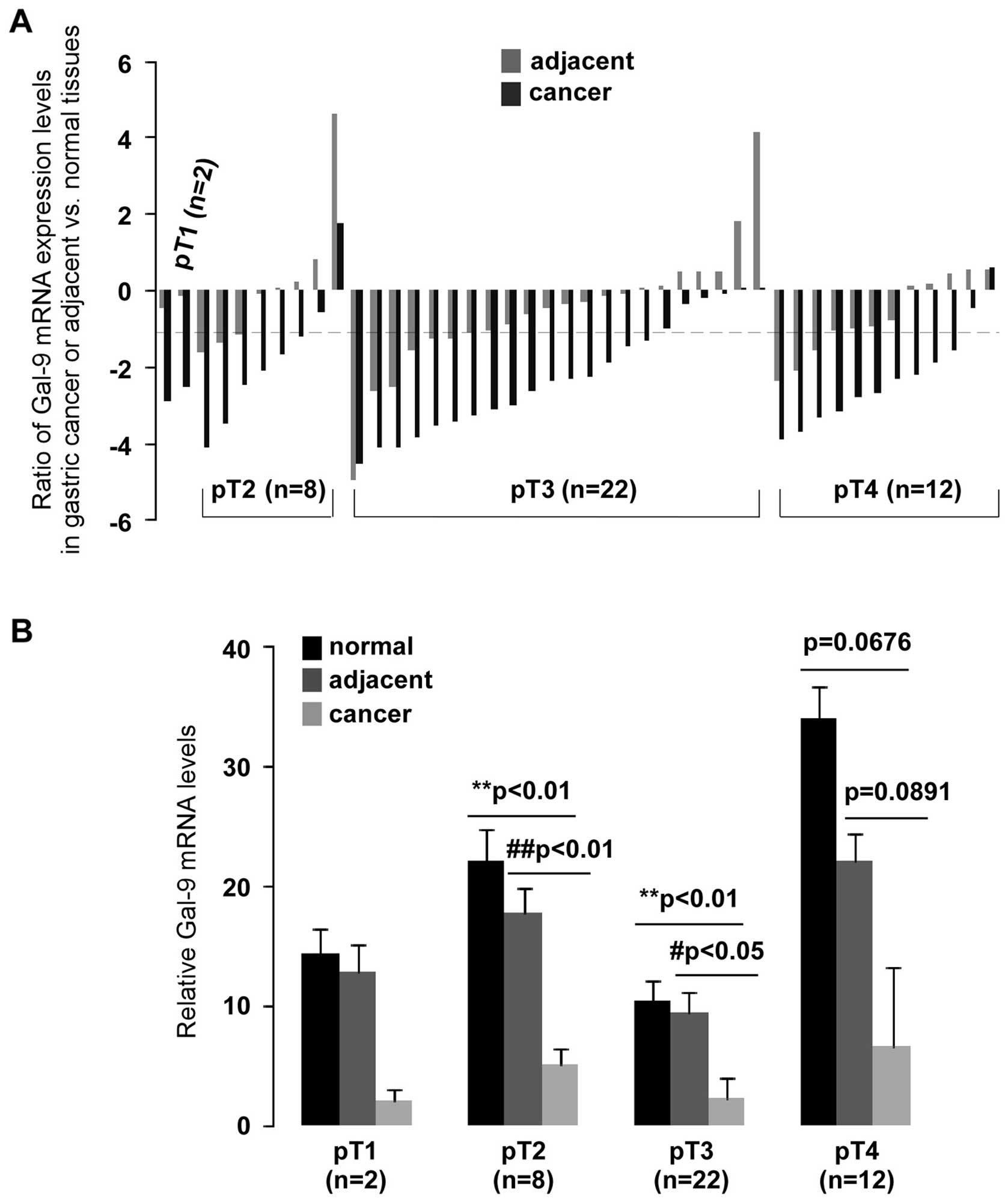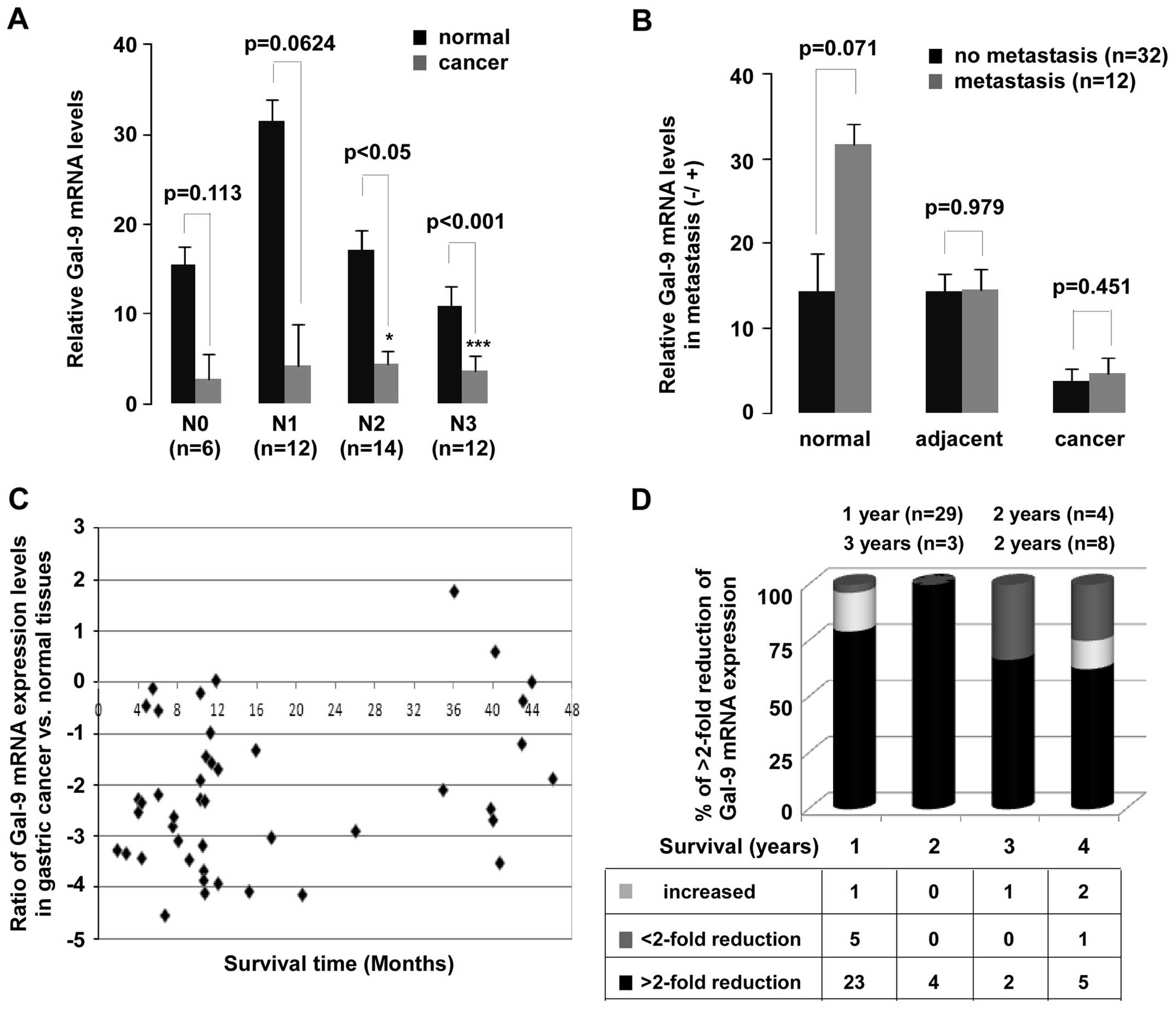|
1
|
Barondes SH, Castronovo V, Cooper DN,
Cummings RD, Drickamer K, Felzi T, Gitt MA, Hirabayashi J, Hughes
C, Kasai K, Leffler H, Liu FT, Lotan R, Mercurio AM, Monsigny M,
Pillai S, Poirer F, Raz A, Rigby PW, Rini JM and Wang JL:
Galectins: a family of animal β-galactoside-binding lectins. Cell.
76:597–598. 1994.
|
|
2
|
Leffler H, Carlsson S, Hedlund M, Qian Y
and Poirier F: Introduction to galectins. Glycoconj J. 19:433–440.
2004. View Article : Google Scholar
|
|
3
|
Hirabayashi J and Kasai K: The family of
metazoan metal-independent beta-galectoside-binding lectins:
structure, function and molecular evolution. Glycobiology.
3:297–304. 1993. View Article : Google Scholar : PubMed/NCBI
|
|
4
|
Heusschen R, Griffioen AW and Thijssen VL:
Galectin-9 in tumor biology: a jack of multiple trades. Biochim
Biophys Acta. 1836:177–185. 2013.PubMed/NCBI
|
|
5
|
Türeci O, Schmitt H, Fadle N, Pfreundschuh
M and Sahin U: Molecular definition of a novel human galectin which
is immunogenic in patients with Hodgkin’s disease. J Biol Chem.
272:6416–6422. 1997.PubMed/NCBI
|
|
6
|
Oda Y, Herrmann J, Gitt MA, Turck CW,
Burlingame AL, Barondes SH and Leffler H: Soluble lactose-binding
lectin from rat intestine with two different carbohydrate-binding
domains in the same peptide chain. J Biol Chem. 268:5929–5939.
1993.PubMed/NCBI
|
|
7
|
Hadari YR, Paz K, Dekel R, Mestrovic T,
Accili D and Zick Y: Galectin-8. A new rat lectin, related to
galectin-4. J Biol Chem. 27:3447–3453. 1995.PubMed/NCBI
|
|
8
|
Sato M, Nishi N, Shoji H, Seki M,
Hashidate T, Hirabayashi J, Kasai Ki K, Hata Y, Suzuki S, Hirashima
M and Nakamura T: Functional analysis of the carbohydrate
recognition domains and a linker peptide of galectin-9 as to
eosinophil chemoattractant activity. Glycobiology. 12:171–197.
2002. View Article : Google Scholar : PubMed/NCBI
|
|
9
|
Oh JH, Yang JO, Hahn Y, Kim MR, Byun SS,
Jeon YJ, Kim JM, Song KS, Noh SM, Kim S, Yoo HS, Kim YS and Kim NS:
Transcriptome analysis of human gastric cancer. Mamm Genome.
16:942–954. 2005. View Article : Google Scholar : PubMed/NCBI
|
|
10
|
Zhang F, Zheng M, Qu Y, Li J, Ji J, Feng
B, Lu A, Li J, Wang M and Liu B: Different roles of galectin-9
isoforms in modulating E-selectin expression and adhesion function
in LoVo colon carcinoma cells. Mol Biol Rep. 36:823–830. 2009.
View Article : Google Scholar
|
|
11
|
Kageshita T, Kashio Y, Yamaguchi A, Seki
M, Abedin MJ, Nishi N, Shoji H, Nakamura T, Ono T and Hirashima M:
Possible role of galectin-9 in cell aggregation and apoptosis of
human melanoma cell lines and its clinical significance. Int J
Cancer. 99:809–816. 2002. View Article : Google Scholar : PubMed/NCBI
|
|
12
|
Lu LH, Nakagawa R, Kashio Y, Ito A, Shoji
H, Nishi N, Hirashima M, Yamaguchi A and Nakamura T:
Charaterization of galectin-9-induced death of Jurkat T cells. J
Biochem. 141:157–172. 2007. View Article : Google Scholar : PubMed/NCBI
|
|
13
|
Kobayashi T, Kuroda J, Ashihara E, Oomizu
S, Terui Y, Taniyama A, Adachi S, Takagi T, Yamamoto M, Sasaki N,
Horiike S, Hatake K, Yamauchi A, Hirashima M and Taniwaki M:
Galectin-9 exhibits anti-myeloma activity through JNK and p38 MAP
kinase pathways. Leukemia. 24:843–850. 2010. View Article : Google Scholar : PubMed/NCBI
|
|
14
|
Kashio Y, Nakamura K, Abedin MJ, Seki M,
Nishi N, Yoshida N, Nakamura T and Hirashima M: Galectin-9 induces
apoptosis through the calcium-calpain-caspase-1 pathway. J Immunol.
170:3631–3636. 2003. View Article : Google Scholar : PubMed/NCBI
|
|
15
|
Irie A, Yamauchi A, Kontani K, Kihara M,
Liu D, Shirato Y, Seki M, Nishi N, Nakamura T, Yokomise H and
Hirashima M: Galectin-9 as a prognostic factor with antimetastatic
potential in breast cancer. Clin Cancer Res. 11:2962–2968. 2005.
View Article : Google Scholar : PubMed/NCBI
|
|
16
|
Zhang ZY, Dong JH, Chen YW, Wang XQ, Li
CH, Wang J, Wang GQ, Li HL and Wang XD: Galectin-9 acts as a
prognostic factor with antimetastatic potential in hepatocellular
carcinoma. Asian Pac J Cancer Prev. 13:2503–2509. 2012. View Article : Google Scholar : PubMed/NCBI
|
|
17
|
Liang M, Ueno M, Oomizu S, Arikawa T,
Shinonaga R, Zhang S, Yamauchi A and Hirashima M: Galectin-9
expression links to malignant potential of cervical squamous cell
carcinoma. J Cancer Res Clin Oncol. 134:899–907. 2008. View Article : Google Scholar : PubMed/NCBI
|
|
18
|
Edge SB, Byrd DR, Compton CC, Fritz AG,
Greene FL and Trotti A: AJCC Cancer Staging Manual. 7th edition.
Springer; Chicago, IL: 2010
|
|
19
|
Zhu C, Anderson AC, Schubart A, Xiong H,
Imitola J, Khoury SJ, Zheng XX, Strom TB and Kuchroo V: The Tim-3
ligand galectin-9 negatively regulates T helper type 1 immunity.
Nat Immunol. 6:1245–1252. 2005. View
Article : Google Scholar : PubMed/NCBI
|
|
20
|
Cooper DN and Barondes SH: God must love
galectins; he made so many of them. Glycobiology. 9:979–984. 1999.
View Article : Google Scholar : PubMed/NCBI
|
|
21
|
Vyakarnam A, Dagher SF, Wang JL and
Patterson RJ: Evidence for a role for galectin-1 in pre-mRNA
splicing. Mol Cell Biol. 17:4730–4737. 1997.PubMed/NCBI
|
|
22
|
Kuwabara I, Kuwabara Y, Yang RY, Schuler
M, Green DR, Zuraw BL, Hsu DK and Liu FT: Galectin-7 (PIG1)
exhibits pro-apoptotic function through JNK activation and
mitochondrial cytochrome c release. J Biol Chem. 277:3487–3497.
2002. View Article : Google Scholar : PubMed/NCBI
|
|
23
|
Yang RY, Hsu DK, Yu L, Ni J and Liu FT:
Cell cycle regulation by galectin-12, a new member of the galectin
superfamily. J Biol Chem. 276:20252–20260. 2001. View Article : Google Scholar : PubMed/NCBI
|
|
24
|
Elola MT, Wolfenstein-Todel C, Troncoso
MF, Vasta GR and Rabinovich GA: Galectins: matricellular
glycan-binding proteins linking cell adhesion, migration, and
survival. Cell Mol Life Sci. 64:1679–1700. 2007. View Article : Google Scholar : PubMed/NCBI
|
|
25
|
Jiang J, Jin MS, Kong F, Cao D, Ma HX, Jia
Z, Wang YP, Suo J and Cao X: Decreased galectin-9 and increased
Tim-3 expression are related to poor prognosis in gastric cancer.
Plos One. 8:e817992013. View Article : Google Scholar : PubMed/NCBI
|
|
26
|
Monney L, Sabatos CA, Gaglia JL, Ryu A,
Waldner H, Chernova T, Manning S, Greenfield EA, Coyle AJ, Sobel
RA, Freeman GJ and Kuchroo VK: Th1-specific cell surface protein
Tim-3 regulates macrophage activation and severity of an autoimmune
disease. Nature. 415:536–541. 2002. View
Article : Google Scholar : PubMed/NCBI
|
|
27
|
Tang ZH, Liang S, Potter J, Jiang X, Mao
HQ and Li Z: Tim-3/galectin-9 regulate the homeostasis of hepatic
NKT cells in a murine model of nonalcoholic fatty liver disease. J
Immunol. 190:1788–1796. 2013. View Article : Google Scholar : PubMed/NCBI
|















